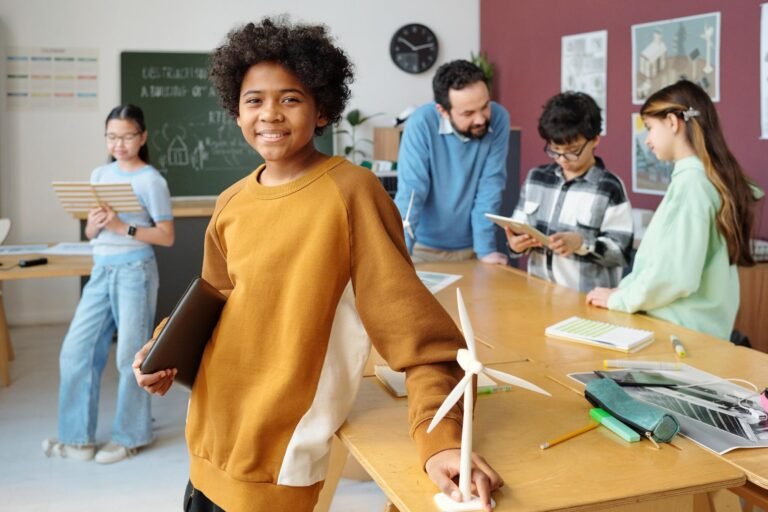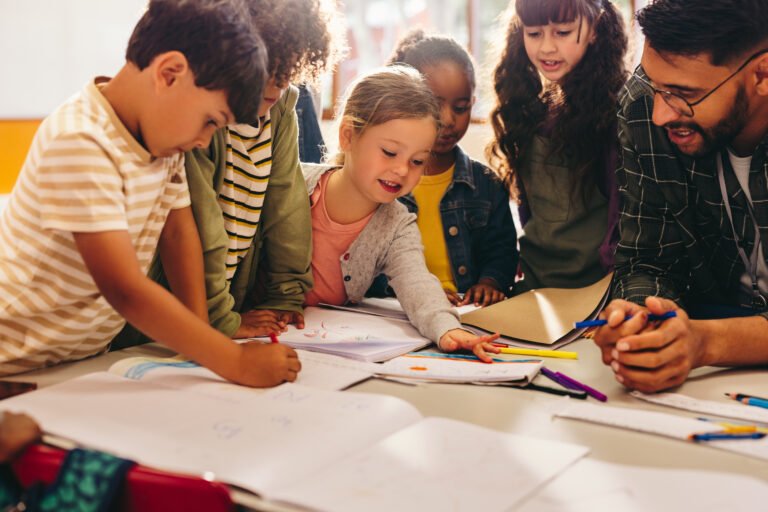
Supporting asynchronously gifted children involves creating a nurturing environment, advocating effectively in educational settings, fostering social skills, and finding community resources to meet their unique developmental needs.
Asynchronous development in gifted children presents a distinct set of challenges and opportunities. It’s fascinating how these kids can excel intellectually while facing hurdles in emotional or social contexts. Have you ever wondered how to bridge that gap?
What is asynchronous development in gifted children?
Asynchronous development refers to the uneven growth of a child’s abilities across different areas. For gifted children, this means they may excel in one area, such as cognitive skills, while facing challenges in others, particularly emotional and social development.
These children can think and process information at a much higher level than their peers, which often leads to advanced reasoning and problem-solving skills. However, their emotional and social skills may not develop at the same pace, leading to feelings of isolation or frustration.
It’s common for gifted children to show early signs of advanced vocabulary or mathematical understanding, yet struggle with peer relationships or managing their emotions effectively. This discrepancy can cause significant challenges for both the child and their parents.
Understanding asynchronous development is crucial for supporting gifted children. Recognizing that their giftedness does not equate to overall maturity helps in addressing their unique needs.
As educators and parents, it’s essential to provide a nurturing environment that promotes strength while also addressing areas where they may need support. Gifted children thrive when given opportunities to explore their interests in a way that honors their individual developmental trajectory.
Characteristics of giftedness and asynchrony
Giftedness often manifests in remarkable talents and abilities, resulting in what is known as asynchronous development. This term describes the uneven growth across different domains, including cognitive, emotional, and social areas.
Characteristics of giftedness include high intelligence, advanced problem-solving skills, and exceptional creativity. These children often process information quickly and make connections that others might miss. However, their emotional development may lag behind their cognitive abilities, leading to challenges in understanding and managing their feelings.
Social skills can also be affected. Gifted children might find it hard to relate to their peers, who may not share their interests. This can cause feelings of isolation or frustration. For instance, a gifted child may excel in math but struggle with group activities or expressing emotions.
Often, these children can be very passionate about their interests, showing extreme focus and dedication. However, they may also experience heightened sensitivity, making them more aware of the emotions of others. This can lead to either exceptional empathy or significant stress in social situations.
Recognizing the signs of giftedness and asynchrony is crucial. It allows parents and teachers to provide the appropriate support, helping children thrive academically and socially while honoring their unique developmental paths.
Understanding the cognitive, emotional, and social development differences
When discussing gifted children, it is essential to understand the differences in their cognitive, emotional, and social development. These aspects do not always progress at the same rate, leading to a unique set of challenges.
Cognitive development in gifted children often exceeds that of their peers. They may grasp complex concepts quickly and demonstrate advanced problem-solving skills. However, this high level of cognitive ability does not always translate into equivalent emotional maturity.
Emotional development can present particular challenges. Gifted children might experience intense feelings and heightened sensitivity. This means they may react strongly in situations where their peers may simply shrug it off. They might struggle with understanding and expressing their emotions, which can lead to frustration or anxiety.
Social development also often lags behind cognitive growth. Gifted children may feel out of place among their peers, making it hard to form friendships. They might enjoy different topics and activities, leading to a sense of isolation. Social skills, such as sharing and empathy, may take longer to develop, impacting their ability to connect with others.
To support gifted children, it’s important for parents and educators to provide environments that cater to all aspects of their development. Understanding these differences allows for tailored approaches that nurture their strengths while addressing their specific needs.
The impact of asynchronous development on learning
Asynchronous development can significantly affect how gifted children learn. Since their abilities do not develop at the same rate across different areas, it can lead to unique learning experiences. Understanding these impacts is crucial for parents and educators.
For instance, a child may excel in academic achievements but struggle with social interactions. This mismatch can lead to feelings of boredom in traditional classrooms, where they are not challenged enough. Gifted children often crave stimulation and may need more advanced materials or an accelerated curriculum.
Additionally, emotional challenges linked to asynchronous development can also impact learning. Children might feel overwhelmed by their emotions, which can hinder focus and performance in school. They may also have difficulty managing stress during tests or presentations, affecting their ability to showcase knowledge.
Supportive learning environments are essential for these children. Providing opportunities for acceleration in subjects where they thrive can keep them engaged. For example, allowing a gifted child to participate in advanced math classes while providing social skills training can address their asynchronous development.
Collaboration and communication with teachers are key in navigating these challenges. Schools that recognize the unique path of a gifted child’s development can foster an enriching educational experience tailored to their needs.
Challenges faced by parents of asynchronously gifted children
Parents of asynchronously gifted children often face a unique set of challenges. One of the main hurdles is understanding their child’s needs. Since these children may excel in intellectual tasks while struggling with emotional or social skills, parents can feel confused about how to support them effectively.
Another challenge is communication. Gifted children often express themselves differently than their peers, which can lead to misunderstandings at home and in school. Parents may need to engage in frequent discussions to help their children articulate their thoughts and feelings.
Social isolation is also a common issue. Many asynchronously gifted children feel like outsiders, unable to connect with peers. Parents might struggle to find suitable social interactions or extracurricular activities that cater to their child’s advanced abilities while also nurturing their social skills.
Additionally, parents often deal with educational challenges. Schools may not always recognize or fully understand asynchronous development. This can result in a lack of appropriate resources or curriculum adjustments, leaving parents to advocate for their child’s educational needs.
Lastly, managing the emotional well-being of asynchronously gifted children can be stressful. Parents must help their children navigate feelings of frustration, anxiety, or perfectionism, which can arise from their unique development pattern. This support is crucial in helping them achieve a balanced life.
Practical tips for supporting asynchronous learners
Supporting asynchronously gifted learners requires a thoughtful approach that addresses their unique development. Here are some practical tips to assist these children effectively:
1. Individualized Learning Plans: Develop customized learning plans that cater to the child’s strengths and weaknesses. This allows for acceleration in subjects where they excel and additional support in areas where they might struggle.
2. Encourage Exploration: Provide opportunities for independent exploration of interests. Encourage children to pursue their passions, whether through books, online courses, or creative projects. This will help maintain their engagement and motivation.
3. Flexible Learning Environments: Create flexible learning environments at home. Allow for variations in daily schedules that accommodate the child’s interests and needs. This might include blocks of time for focused study or time for creative thinking.
4. Social Skills Development: Facilitate social interactions with peers who share similar interests or abilities. This can be done through clubs, classes, or group projects that encourage collaboration. Helping them develop social skills can lead to better peer relationships.
5. Emotional Support: Provide a safe space for children to express their feelings. Acknowledge their challenges and help them navigate emotions. Listening and validating their experiences can enhance their emotional resilience.
6. Maintain Open Communication: Regularly communicate with teachers to ensure that the child’s needs are met in school. Being proactive helps in advocating for appropriate resources and adjustments tailored to the child’s asynchronous development.
By incorporating these strategies, parents and educators can create a supportive environment that fosters growth and helps asynchronously gifted children thrive.
Creating a supportive learning environment
Creating a supportive learning environment is essential for asynchronously gifted children. This type of environment addresses their unique needs and fosters both intellectual and emotional growth. Here are key elements to consider:
1. Flexible Learning Spaces: Design a learning space that is adaptable. Include areas for quiet study, collaborative projects, and creative activities. This flexibility allows children to choose where and how they learn best.
2. Cater to Individual Interests: Incorporate the child’s interests into their learning activities. When children engage with topics they love, they become more motivated and excited about learning. Tailoring lessons to fit their passions can make a significant difference.
3. Encourage Curiosity: Promote an atmosphere where questions and exploration are welcomed. Give children the freedom to ask questions and pursue answers that fascinate them. This encouragement boosts their confidence and desire for knowledge.
4. Provide Emotional Support: Acknowledge and validate their feelings. Understanding that asynchronous learners often experience intense emotions is crucial. Offering support through active listening and empathy can help children feel secure.
5. Foster Peer Connections: Facilitate opportunities for children to connect with peers who have similar interests. Group activities, clubs, or team projects can create supportive friendships and improve social skills.
6. Collaborate with Educators: Maintain open communication with teachers to ensure they understand and support the child’s unique learning style. Involving educators in the process helps create a cohesive approach to their development.
By implementing these strategies, parents and educators can create a nurturing learning environment that meets the diverse needs of asynchronously gifted children.
Encouraging peer interactions and social skills
Encouraging peer interactions and social skills in asynchronously gifted children is crucial for their overall development. Here are some effective strategies to foster these skills:
1. Create Group Opportunities: Facilitate group activities that promote teamwork. Projects, clubs, or group sports can help gifted children learn to work with others and appreciate diverse perspectives.
2. Encourage Shared Interests: Help children find peers who share similar interests. This can be done through extracurricular activities or community events. Connecting with like-minded individuals can make social interactions more enjoyable and meaningful.
3. Role-Playing Exercises: Use role-playing scenarios to practice social situations. This can boost their confidence and help them learn appropriate responses to various social cues. Role-playing can be particularly useful for handling conflict or unfamiliar situations.
4. Discuss Emotions: Teach children to articulate their feelings and understand the emotions of others. Discussing feelings openly can improve their empathy and enhance their interactions with peers.
5. Set Up Playdates: Organize playdates with other children to encourage social bonding. Structured activities during playdates can help guide interactions and provide a platform for practicing social skills.
6. Limit Screen Time: Encourage face-to-face interactions by limiting screen time. While technology has its benefits, personal interactions are vital for developing essential social skills.
7. Provide Positive Feedback: Reinforce successful social interactions by offering praise and encouragement. Positive reinforcement can motivate children to continue practicing their social skills.
By implementing these strategies, parents and educators can support asynchronously gifted children in developing strong social skills and forming meaningful relationships with their peers.
Advocating for gifted children in educational settings
Advocating for gifted children in educational settings is vital to ensure they receive the support they need. Here are key strategies parents and educators can use:
1. Understand Individual Needs: Every gifted child is unique. Take the time to understand their specific strengths and weaknesses. This knowledge allows you to advocate effectively for appropriate educational adjustments.
2. Build Relationships with Educators: Establish strong connections with teachers and school staff. Open communication can help you share your child’s needs and seek tailored educational solutions. Engaging educators in discussions also fosters collaboration.
3. Provide Documentation: Gather relevant information about your child’s abilities. Document test scores, assessments, and examples of their work. This evidence is essential for discussing appropriate programs and placements with school personnel.
4. Promote Differentiated Instruction: Advocate for differentiated learning opportunities in the classroom. Gifted children benefit from being challenged with advanced material that meets their learning pace and interests.
5. Form Advocacy Groups: Join or create parent advocacy groups within the school community. Collaborating with others provides a stronger voice and allows for sharing resources and strategies for effective advocacy.
6. Educate the School Community: Offer resources and training sessions about gifted education for teachers and staff. Raising awareness about the needs of gifted children can enhance overall understanding and support in the school environment.
7. Monitor Progress: Regularly check in on your child’s academic progress and emotional well-being. Stay engaged with their learning journey to ensure they are being supported appropriately in school.
By employing these strategies, parents and educators can create an environment that nurtures the potential of gifted children, allowing them to thrive academically and socially.
Finding community and resources for parents
Finding a supportive community and resources is essential for parents of asynchronously gifted children. Here are some ways to connect with others and access helpful information:
1. Online Support Groups: Join online forums and social media groups specifically for parents of gifted children. These platforms provide a space to share experiences, ask questions, and get advice from others facing similar challenges.
2. Local Parent Organizations: Look for local parent organizations or support groups dedicated to gifted education. These groups often offer workshops, social events, and resources that can be very beneficial.
3. Educational Workshops: Attend workshops and seminars focused on enhancing the understanding of giftedness. These events provide valuable insights and strategies for supporting your child’s unique needs.
4. Books and Online Resources: Utilize books and online resources that focus on parenting gifted children. Websites, blogs, and podcasts often share testimonials, expert advice, and practical tips.
5. Collaborate with Educators: Establish communication with teachers and counselors who specialize in gifted education. They may have useful resources or connections to community programs that cater to gifted learners.
6. Participate in Community Events: Engage in community events that promote intellectual engagement for gifted children. Programs such as science fairs, art exhibits, and literary clubs can provide children with opportunities to connect with their peers and develop their talents.
7. Create Connections: Don’t hesitate to reach out to other parents in your child’s school. Building relationships within the school community can help you discover resources and support networks that may not be widely advertised.
By actively seeking out community and resources, parents can enhance their understanding and support of asynchronously gifted children, making the journey more manageable and enjoyable.
Supporting Asynchronously Gifted Children
Supporting asynchronously gifted children requires understanding their unique needs and challenges. By creating a nurturing environment, advocating effectively, and finding community resources, parents and educators can help these children thrive.
Encouraging peer interactions and social skills is essential for their development, as is providing opportunities for independent exploration of their interests. Collaboration with educators and utilizing available resources can greatly enhance the learning experience for gifted children.
As you navigate this rewarding journey, remember that you are not alone. Connecting with other parents and sharing experiences can lead to valuable insights and support. Together, we can foster an environment where asynchronously gifted children can reach their full potential.
FAQ – Frequently Asked Questions about Supporting Asynchronously Gifted Children
What is asynchronous development in gifted children?
Asynchronous development refers to the uneven growth of a child’s abilities across cognitive, emotional, and social areas, leading to challenges in their overall development.
How can I create a supportive learning environment for my gifted child?
Design a flexible learning space that caters to your child’s interests and encourages exploration while providing emotional support and opportunities for social interactions.
What are some effective ways to advocate for my gifted child in school?
Build strong relationships with educators, provide documentation of your child’s abilities, and promote differentiation in instruction to meet their unique learning needs.
How can I help my child develop social skills?
Encourage engagement in group activities, facilitate playdates, and use role-playing exercises to practice various social situations.
Where can I find resources and communities for parents of gifted children?
Look for online support groups, local parent organizations, and educational workshops that focus on gifted education to connect with other parents and gain valuable resources.
Why is emotional support important for gifted children?
Gifted children often experience intense feelings and may struggle with social interactions. Providing emotional support helps them navigate their challenges and fosters resilience.

A certified Heal Your Life® Coach with 20+ years in education and emotional development. Supports gifted teens in navigating anxiety, perfectionism, and identity challenges, while equipping parents with practical tools for lasting transformation. Sessions blend emotional healing, mindset mastery, and strategic empowerment.



